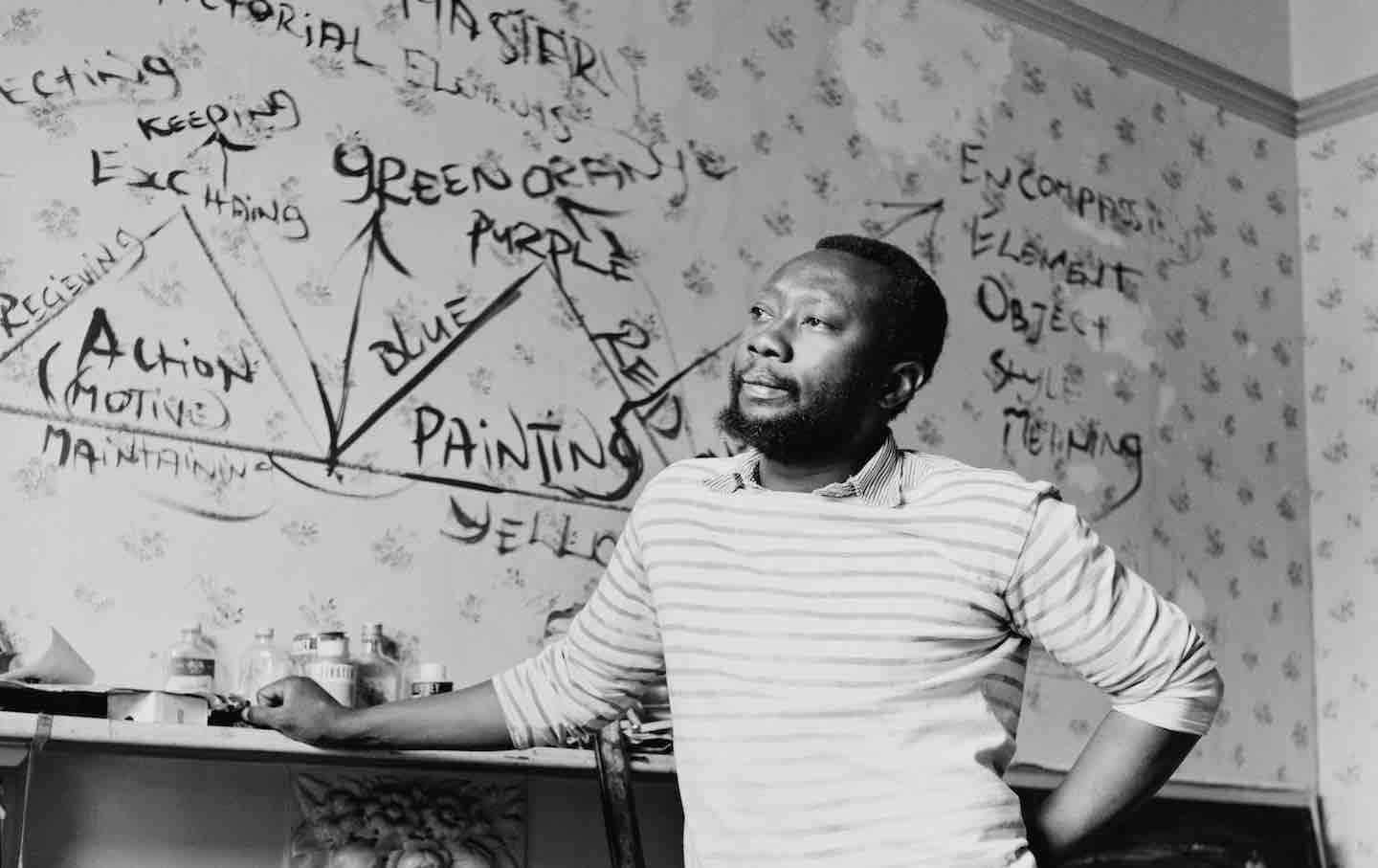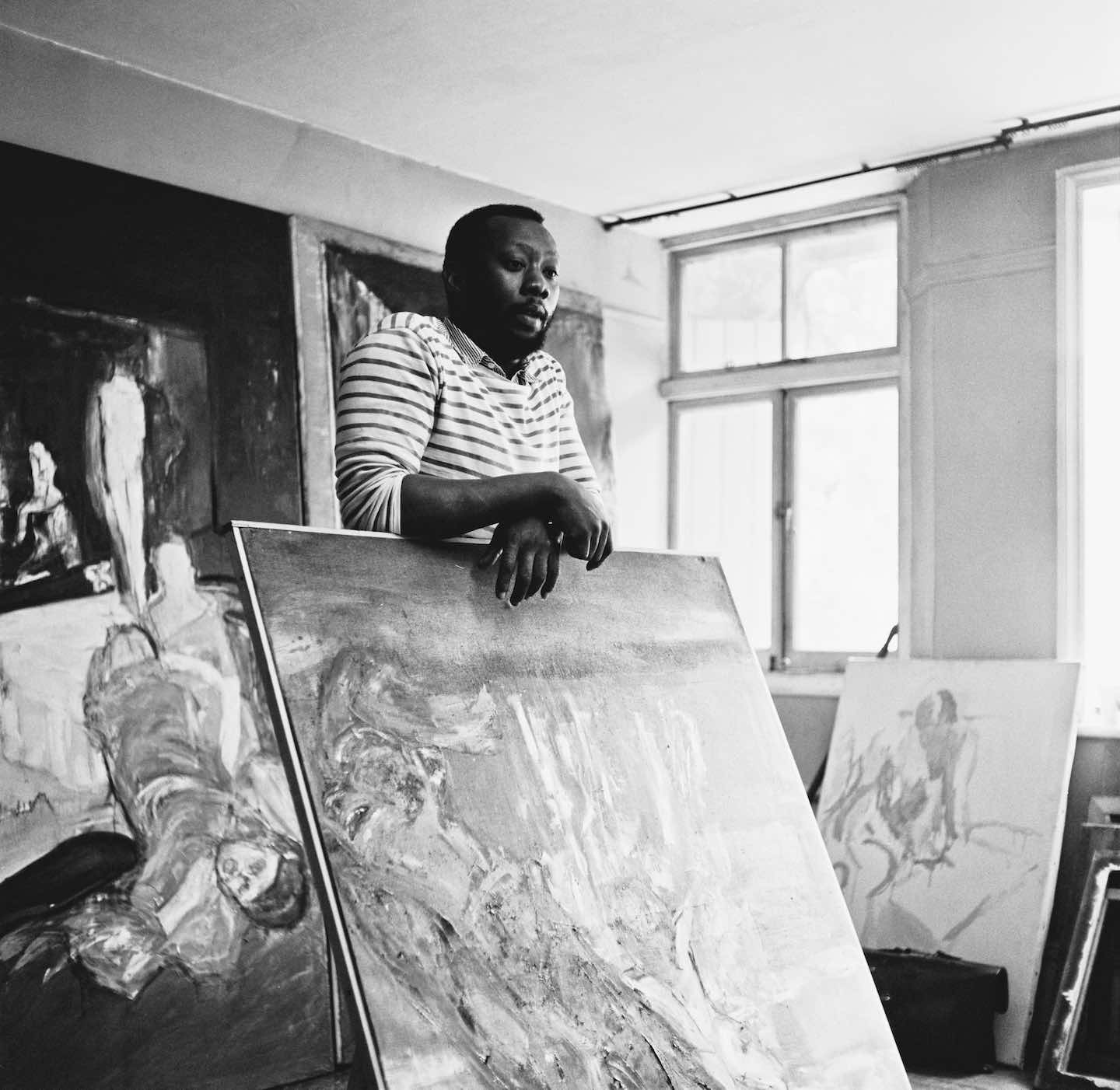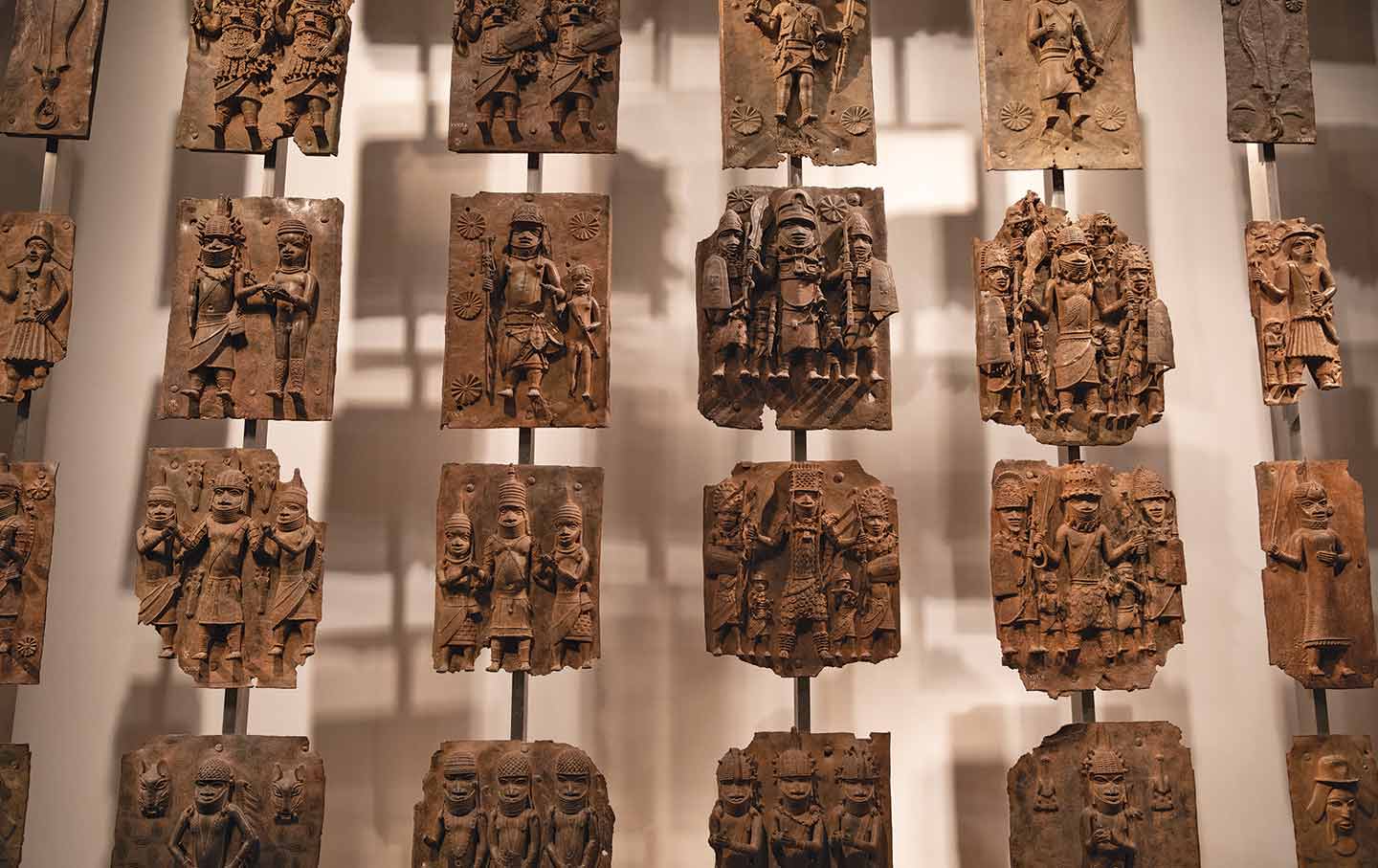“The Subject of Painting Is Paint”: On Frank Bowling
The British artist’s work challenges all notions you might have about the relationship between politics and aesthetics.

Frank Bowling, 1965.
(Photo by Tony Evans / Getty Images)Frank Bowling has a knack for keeping himself just out of view; his work excels at provoking and then rejecting attempts to draw connections between it and its author, who moved from Guyana to London in 1953 and made a name for himself as an abstract artist across both sides of the Atlantic. Bowling’s career followed an odd trajectory compared with those of other Black artists born in the first half of the 20th century: He eventually left Europe for America, rather than the other way around, finding in New York City an environment more congenial to his attempts to express himself creatively.
Yet, in 1975, Bowling moved back to England after almost a decade in New York, and his studio sits in a mews in South London, opposite an office in which archivists are in the process of diligently cataloging the artist’s papers, paintings, articles, and correspondence. It was to review the latter that I came to South London. On a hot afternoon in August, as I read through his exchanges with the critic Clement Greenberg—in which the two discussed everything from Anthony Caro’s sculptures to Bowling’s children and the habit both men had of writing letters while drunk—a black car pulled up outside, its passenger not quite visible through the window.
This, I was told, was Bowling, who, at 89, still visits his studio almost daily. His energy is limited these days, and he prefers to give it to his work rather than to journalists. Of late, Bowling’s son, the criminologist Ben Bowling, has taken up some of the responsibilities of speaking at events and attending gallery openings for the octogenarian. After spending several hours alone with Bowling’s papers, though I would never get a chance to meet the artist, Ben gave me a tour of his father’s studio to see his works in progress. “I often say to Frank that the whole operation around him”—the physical therapist, the driver, the assistants who help prepare him for intense bursts of creative work—“is like Formula 1,” Ben told me as he guided me to a room containing two canvases, one pinned to the wall and the other to the floor.
Bowling’s work, abstract since the late 1960s, consists of large canvases painted with acrylic. He sometimes pours the paint, allowing it to drip in straight lines that form rows of color. These areas he often offsets against geometrical lines or more controlled spaces in which the lighter washes of color, with their sunlit hues, are reminiscent of the work of Bowling’s fellow abstract painter Helen Frankenthaler. The paintings in progress at his studio, two canvases suffused with lime greens and sunset oranges, combined straight lines made by the dripped streaks with rectangular fields of blended color interspersed with paint that Bowling has allowed to sit impasto—thick enough to make its texture visible—across parts of the canvas. These large paintings, with their muddy undertones peeking out through bright reds, oranges, and greens, evoke a landscape reminiscent of neither the dense metropolis of New York nor the heavily regimented English countryside.
Patiently, Ben talked me through his father’s process. He drew my attention to a series of overlapping rectangles on the wall, the afterimages of previous paintings, stained with the lush blues, yellows, and greens of the canvases in the studio and others since completed. As Bowling works on the portion of the canvas temporarily affixed to the wall, pools of paint amass at its base. This creates two spaces within the canvas, the first marked by the lines made by poured paint and the second by the loose, cloud-like fields of color formed by the excess paint that has dripped down onto the portion of the canvas that streams out on the floor. It feels apposite that what divides these two spaces—the right angle between the floor and the wall—is not available to the viewer, who will encounter Bowling’s work in the sanitized space of an art gallery. Much like Bowling himself, his art bears few marks of a connection to the world out of which it has emerged.
Since the start of Bowling’s career, he has had an uneasy relationship to the external sources of influence on his work, which he has carefully kept out of view. Born in 1934 in Guyana, then a British colony, Bowling was the product of a Guyanese middle class that produced throughout the postwar years a stream of remarkable painters such as Donald Locke, Stanley Greaves, and Aubrey Williams, all of whom worked within the modernist tradition, along with poets like Wilson Harris and the great historian of global inequality Walter Rodney. Bowling was the son of an enterprising mother, the owner of Bowling’s Variety Store, which sold everything from toys and household appliances to food, an eclecticism whose residue can be gleaned in the artist’s most recent canvases, which use found materials, often taken from the pockets of visitors to his studio.
A stenciled illustration of the shop features in much of Bowling’s early work too, although with his move to abstraction in the late 1960s came a turning away from a reliance on these images. “Gradually,” Bowling has recalled, “I decided to erase, say, the image of my mother and replace it with shape, color and structure.” His father was a taciturn accountant, and Bowling has said that he does not remember ever having had a conversation with him. Raised in an era of imperial cosmopolitanism, Bowling viewed his move to the metropole as “no more significant than moving from, say, Leeds or Manchester to London.”
Accordingly, when he arrived in London as a 19-year-old, Bowling described his voyage as a homecoming. After almost three years as a mechanic in the Royal Air Force, which he joined on the ill-fated expectation of being given a free education, Bowling officially began his artistic training at the Chelsea School of Art and then the Royal College of Art, where he was classmates with David Hockney. Though in those early years, he produced work that was nominally political—an early oil painting from 1961, in a style strongly influenced by Francis Bacon, is titled Martyrdom of Patrice Lumumba, after Congo’s socialist president, who was slain after a military coup aided and abetted by the CIA—Bowling’s interests have mostly gravitated toward formal questions rather than the social changes in the world around him. In his exchanges with Greenberg, who at the time was the most lucid and compelling defender of abstract art in the Anglophone world, he writes of the difficulty with which he sought to dislodge himself from the grip of political art, which he felt put provincializing constraints on him as a Black artist.
In his early years, Bowling fused a mishmash of visual techniques: pained and contorted figures inspired by Bacon; stencils of his mother’s store in Guyana and images taken from advertising, à la the emerging Pop Art movement; the color-field paintings of Kenneth Noland; and sharp geometrical patterns that played with the borders of the canvas, reminiscent of Mondrian, the subject of Bowling’s doctoral dissertation at the Royal College. These themes came together in Mirror (1964–66), a work that depicted Bowling and his then-wife, the novelist Paddy Kitchen, descending the stairs from the Royal College painting school to the Victoria and Albert Museum, a prestigious home to applied and decorative arts in London. In the painting, Bowling and Kitchen—both depicted in a Bacon-esque style, with faces contorted into agonized expressions, as if they had been placed briefly inside a blender—descend into a world of pictorial flatness, represented by red and navy tiles modeled on the work of the Hungarian-French optical-illusionist artist Victor Vasarely.
In representing this transition from figuration to abstraction, Bowling was expressing a view about the development of the history of art very similar to that of Greenberg, although the two men would not meet until the 1970s. For Greenberg, it had taken until the first half of the 20th century for painting to finally rid itself of the shame of realism and its staid adherence to the real world. In a review of Bowling’s map paintings from 1970—abstract acrylic works that used the outlines of Australia, Guyana, South America, and Africa to structure the colors in which they are embedded—the artist Marcia Hafif proclaimed that in them, “paint can be paint again and does not have to apologize for its illusion-provoking qualities.”
This excitement was a response to what Greenberg had already diagnosed in 1948 as the crisis of easel painting. Traditional painting, he argued, held on to the illusion of being a box-like cavity in which a theatrical scene played out for the viewer in an imaginary three-dimensional space. It relied fundamentally on the observer’s expectations of how objects and people in that imagined space ought to behave. But with the emergence of modernism, such expectations were increasingly challenged, and it became impossible to re-create the realism found in Vermeer without appearing naïve. What was needed instead was an art that recognized its status as art and embraced, rather than disavowed, the fact that it was an object hung on a wall and made of paint.
But at least since Manet’s Olympia—whose flatness Courbet famously mocked by describing it as resembling the queen of spades after a bath—painters had recognized that the emphasis in an image could be spread equally, without giving preference to depth or re-creating in the artwork the world outside of it. In his most grandiose moments, Greenberg and other devotees of what came to be called the Abstract Expressionist movement, Formalism, or, more simply, the American modernist style of painting, declared this revolution the final victory of human freedom over the demands of representation.
Against both the commodified stupidity of capitalist kitsch and the authoritarian simplifications of reality proffered by Stalinism, Abstract Expressionism cut a middle path. What Bowling’s map paintings did, then, was take an image of a nation or a continent and tear it from its historical meaning, subordinating that to the visual effects created by tone and shape. Looking at them, one is forced to abandon what was, throughout the 1970s and ’80s, the growing trend of interpreting Black art in terms of biography, race, and national origin in favor of something more conceptually uncertain.

In 1969, Bowling curated “5+1,” an exhibition of his own pieces alongside those of the sculptors Mel Edwards and Daniel Johnson and the painters Al Loving, Jack Whitten, and William T. Williams—all Black artists working unapologetically in a modernist vein. An approach common to interpreting the work of Black abstract artists is to see their turn away from figuration as symbolizing some response to history or trauma—but this, as the art historian Darby English has argued in 1971: A Year in the Life of Color, his study of Black abstract artists in the US, is to stay within the confines of a representational way of thinking about art and its functions. It is guilty of what English calls the “aggressive domestication of emphatically noncompliant paintings,” denying to Black artists the possibility that they could be working in the medium in purely artistic rather than personal terms. Ben Bowling, paraphrasing his father’s own views of his work, has put this point even more succinctly: For Bowling, “the subject of painting is paint.” This might be a difficult idea to grasp, but accepting it—or at least finding it intelligible—is essential to understanding the playfulness and inventive engagement with issues of identity found in Bowling’s work.
Who’s Afraid of Barney Newman (1968) takes this approach to its extreme. Alluding to Barnett Newman’s “zip” paintings, so called because of the vertical line that extends from the top to the bottom of the canvas, the work evinces Bowling’s departure from the symbolic register entirely. In Newman’s paintings, the effect of the zip is to create a new way of reading an image in which two blocks of color relate to one another, as perhaps a landscape and a seascape might, but without alluding to three-dimensional space. In Bowling’s painting, a map of Guyana sits along the seam of yellow that runs vertically down the canvas, separating a block of red from a block of green. Commentators have observed that the colors could be read as an allusion to the Guyanese flag, adopted two years before Who’s Afraid of Barney Newman was completed. But what strikes me about this painting is how devoid of symbolism the map and the colors become when separated by the zip.
There is something incongruous about the whole combination—a refusal to be read as anything other than shape and color relating to one another. The sense one gets upon looking at the image is that any symbol can be pulled away from its traditional context and remade; in the struggle between art and reality, art can come out victorious. In his 1971 essay “It’s Not Enough to Say Black Is Beautiful,” in which he commented on what he saw as the confused notion of Black art, Bowling—as sharp-witted in prose as he is on the canvas—observed that “we have not been able to detect in any kind of universal sense The Black Experience wedged-up in the flat bed between red and green: between say a red stripe and a green stripe.” The upshot of this worldview, when applied to thinking about race and its place in art, is clear: Insofar as Bowling’s paintings represented anything, it was the process of their creation.
After moving to New York in 1966, Bowling would return to London in 1975, but he continued to travel back and forth between the two cities. On both sides of the Atlantic, modernism—already waning by the time of Bowling’s arrival in America—was falling out of favor. The rising currents of Black nationalism, which was as much a cultural as a political project, jarred with Bowling’s own aesthetic outlook: In his writing, he insisted that it was not that he thought there was no such thing as Black experience, but rather that to find a visual language that expressed it, one needed to reject tropes and clichés and give to symbols, such as national colors and maps, a meaning that broke from that found in the world. “Blackness,” he wrote in the 1988 essay “Formalist Art and Black Experience,” is “no more expressed, in the literal sense, by painting a black face than by a black line.”
Popular
“swipe left below to view more authors”Swipe →But this insistence that the social world was ultimately subordinate to artistic self-expression fit uneasily with Bowling’s work: Paintings such as Middle Passage (1970) alluded to a set of meanings that escaped the confines of the canvas. Some path needed to be drawn back from life, reality, and experience to art—but how? In an interview, Spencer Richards, a Guyanese artist and friend of Bowling’s who began assisting him in 1996, remarked on the sensitivity required to be able to understand the connection between an artistic oeuvre and the experiences that inform it. Richards observed that Rosignol, the name of a painting from 1997, is also that of a stelling—a position on the shoreline, usually of a Dutch colony—located near New Amsterdam, Guyana. Bowling, who spent much of his early career frustrated at being pigeonholed as a Black artist, found in this thought a challenge to many of his assumptions about his own work.
When he arrived in London in the 1960s, proclaiming that he was finally home, Bowling saw the washed-out colors of his landscapes as allusions to an English tradition of painting into which he was attempting to insert himself. But as Richards pointed out, the “rum reds and oranges” we see in the painting are “evocative of a sunset.” This meant that the vantage point from which Bowling was casting his artist’s eye on the world was from the Guyanese shoreline. Previously, he had bristled at claims that his work employed a “tropical” color scheme, an interpretation that helped itself too readily to an understanding of his life. However, Richards’s observation made clear that a connection between work and life could be made, even in the most abstract of art.
In our own time, in which making links between art and life has become an unavoidable part of criticism, it is easy to sympathize with Bowling’s cagey withdrawal. Perceived insights into the background of an artist can very quickly morph into generalizations that smother their work in happenstance and random context.
Leaving the studio, I thought that perhaps I should have made some effort to actually meet Bowling, who, at worst, would have responded with polite annoyance. But the appeal of his work, to me, has always been the unavailability of its author. Although notions of the mysteriousness of artists can make for their own tired tropes, they help reinforce the illusion—often undermined by the overly biographical nature of so much cultural production—of an unpassable wall between art and the artist. Bowling’s work and practice suggest that, although it is impossible to completely maintain this illusion, the attempt to understand the connection between an artist and his work requires first abandoning preconceptions about both.
More from The Nation

The Agony of Aaron Rodgers The Agony of Aaron Rodgers
Is he the world’s most interesting athlete or is he just a washed-up crackpot?

Can You Understand Ireland Through One Family’s Terrible Secret? Can You Understand Ireland Through One Family’s Terrible Secret?
In Missing Persons, Clair Wills's intimate story of institutionalized Irish women and children, shows how a family's history and a nation’s history run in parallel.

Peter Schjeldahl’s Pleasure Principle Peter Schjeldahl’s Pleasure Principle
His art criticism fixated on the narcissism of the entire enterprise. But over six decades, his work proved that a critic could be an artist too.

How the Western Literary Canon Made the World Worse How the Western Literary Canon Made the World Worse
A talk with Dionne Brand about her recent book, Salvage, which looks at how the classic texts of Anglo-American fiction helped abet the crimes of capitalism, colonialism, and more...

Along the Roads That Built Modern Brazil Along the Roads That Built Modern Brazil
José Henrique Bortoluci's What Is Mine tells the story of his country’s laborers, like his father, who built its infrastructure, and in turn its fractious politics.

The Long History of the "Elsewhere Museum" The Long History of the "Elsewhere Museum"
Can the ethnographic museum be reinvented?


